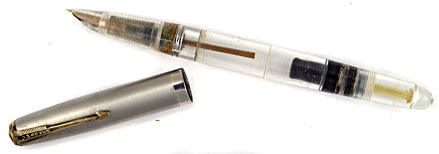
Demonstrators were not originally sold to the public. They were used as sales tools to show customers how a pen or pencil was constructed and how it functioned, and to instruct repairmen. The first demonstrators were cutaways, also called "skeleton" pens. Later on, transparent plastics were used, as with the 1947 Parker 51 demonstrator in clear acrylic shown above.
![]()
![]()
Above we see a Waterman 54 cutaway c. 1920 and a Parker Vacumatic cutaway c. 1937. The cutouts in the Waterman's barrel show the lever-filling mechanism and pressure bar, while the cap cutout shows the inner cap and how it seals against the front of the section. Cutaway pens often lacked nonessential parts, notably nibs, as they were not intended to be fully functional. The all-metal Sheaffer pencil below from the early to mid-1920s may have all the parts of its uncut version, but its exposed mechanism would surely cause problems if carried regularly in a pocket.
![]()
The first transparent demonstrators appear to have been introduced by Parker. Only the barrels were transparent, made of ruby-red Bakelite. According to contemporary Parker literature, there was sufficient interest in these dealer-only versions that Bakelite-barreled pens were subsequently put into full production for sale to the general public. Vintage pen collectors do not regard transparent-barreled pens as true demonstrators unless they were dealer-only models. This is a meaningful distinction, but at the same time not always one that can readily be drawn -- the early Parkers being a case in point.

A more straightforward example is the early Parker Vacuum Filler/Vacumatic "Crystal" model. Only the barrel was transparent; the example above shows typical darkening of the celluloid, which was originally clear with a faint straw hue. While these pens were advertised and sold to the public, they were also used as demonstrators, their barrels imprinted "DEMONSTRATOR" and commonly also "NOT FOR SALE". The demonstrably demonstrator versions are much scarcer, and more highly sought after.
![]()
Pen manufacturers made less use of demonstrators as large-scale advertising campaigns increasingly overshadowed over-the-counter salesmanship. This was especially the case for models of relatively conservative design, such as the late 1940s Waterman lever-filler above, which lacked any particularly novel internal features to be highlighted. The clarity of the material indicates that it is acrylic, rather than celluloid.
![]()
The prewar British Onoto demonstrator above, by contrast, had a plunger-filling mechanism whose operation would not have been intuitively obvious to the average consumer, plus an ink shutoff valve shown in the cutaway section. The rarity of this model, though, suggests that it may have been intended for in-house training rather than sales promotion. Because this pen is a cutaway and unfillable, the original clarity of the celluloid has been preserved.
![]()
The question of how much there was to demonstrate may also explain why Sheaffer Touchdown demonstrators are so much less common than Sheaffer Snorkel demonstrators. The far more complex and novel internal workings of the Snorkel -- often described as the most complicated mass-produced fountain pen ever made -- were ideally explained in see-through form.
![]()
The German Montblanc 24 was a conventional piston-filler, but its partially shrouded nib was unusual and well suited to being shown off in demonstrator form. The pen's clear cap also allowed the internal metal clutch arrangement to be seen. German companies made extensive use of transparent demonstrators in the postwar decades. The general adoption of injection molding in the postwar pen industry made demonstrator production easier, as parts came out of the mold requiring only minimal finishing work, inside and out.

The modern vogue for transparent pens would appear to date back to the early 1990s, when Pelikan introduced a limited-production version of their flagship M800 in transparent green, followed by the transparent blue Blue Ocean and then several other releases of smaller transparent pens in a variety of colors. Although some clear and clear-barreled pens had been offered before, the popularity of Pelikan's offerings was what pushed so many other modern makers to follow suit, launching the era of the modern demonstrator. Although a few purists argue that modern transparent pens aren't really demonstrators, that is a pointless effort to impose the standards of one era on another. Modern transparent pens are sold as demonstrators, after all, and they undoubtedly demonstrate. Where a distinction can usefully be drawn is between vintage demonstrators and modern, the former being scarce special-purpose versions not sold to the public, the latter sold to all, albeit sometimes in limited numbers.
Link to vintage demonstrators for sale
Link to modern demonstrators for sale